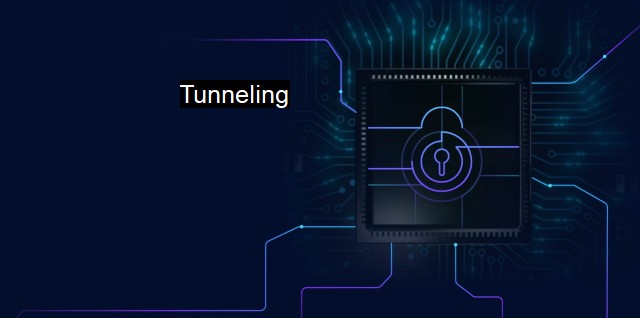What is Tunneling?
The Importance of Tunneling in Cybersecurity: Ensuring Secure Data Transmission over Public and Private Networks.
In the realm of internet technology and specifically in the sphere of cybersecurity, the term "tunneling" takes on a much different definition. It is not about constructing physical passageways underground, but rather about creating virtual pathways through a network. It’s important to understand that in using the term "tunneling," tech experts refer to methods for transmitting data from one place to another through designated servers and paths that defy traditional network paths.Tunneling in cybersecurity is a method of transmitting data securely over a public network, such as the internet. More precisely, it's a communication method wherein a private network is expanded across public networks, providing isolation and security. It usually involves encapsulating an entire network protocol within packets carried by the second network, analogous to shipping cargo inside a box that hides the cargo's identity.
One recognizable type of tunneling is VPN (Virtual Private Network) tunneling. The technology behind them guarantees security by encapsulating data inside a secure protocol that can be decrypted only by legitimate users. This means no unauthorized user can penetrate or compromise the content of the tunnel, and therefore user traffic remains confidential and secure.
This sort of covert communication crucially protects both business and personal users. The formation of VPN pathways or tunnels means that people can transmit information over networks without worrying about the data being exposed to those who might exploit it. while VPNs and other types of tunneling can be instrumental in securing data for traditional purposes, they can and have been used disadvantageously.
In some cases, tunneling is a tool for those who want to bypass network security systems and standards. An intruder could tunnel into a system by hiding or disguising their data transmissions as regular network traffic. Thus, intrusion detection systems (IDS) or antivirus can't recognize this malicious traffic.
An intruder may launch a VPN application and project a copy of the network data into another VPN. While the network can recognize the data communication, it can't interpret the woven signature of the VPN, rendering it unreadly clear to detect violations of usage - i.e., a successful tunneling attack. It's one way many online threats have cloaked their operations within networks, evading antivirus and other types of security software.
These scenarios mean that businesses and corporations need to have robust security measures that encompass tunneling intrusion scenarios. Aside from conventional cybersecurity apparatus, there is a need for a separate cybersecurity technology that addresses threats at this deeper layer.
Firewalls equipped with deep packet inspection or intrusion detection systems can identify and block such malicious tunnels. They've been designed to analyze data transmitted across networks at various layers. Besides, some cybersecurity programs can monitor and regulate VPN usage, dramatically reducing the chance of illegal tunneling.
Untypically, while tunneling can deliver crucial benefits for individual users and businesses, it is also a double-edged sword. As protocols change and the field of cybersecurity evolves, methods for bypassing further security may emerge. Undoubtedly, this will stir responses from security experts who will invent new ways of detecting and combating illegal tunneling.
Tunneling plays an integral part in both how data transfers are safely performed, and how network security failures occur. One has to be utterly cognizant of its benefits, strategically implementing precautions, and up-to-date mitigations. Multiple times, a user's understanding, caution, and accounting for the risks and rewards of tunneling will determine their aptitude to capitalize on its advantages, without becoming susceptible to its potential threats. The cybersecurity ecosystem must continuously evolve in response to the changing tactics of those who would exploit its weaknesses, with tunneling being a case in point. As with many components of choosing technology, it becomes a trade-off between utility and potential risk.

Tunneling FAQs
What is tunneling?
Tunneling is a process of sending data or network traffic through a secure and encrypted connection from one network to another over an unsecured network, such as the internet. It provides a secure way of transmitting information between networks and helps prevent unauthorized access and eavesdropping.How does tunneling help in cybersecurity?
Tunneling enhances cybersecurity by creating a secure and encrypted connection between networks, making it difficult for hackers to intercept and steal sensitive information. It also allows users to access remote resources securely, such as accessing a work network from a personal device without compromising the security of the network.What are the common protocols used for tunneling in cybersecurity?
The common protocols used for tunneling in cybersecurity are Secure Shell (SSH), Transport Layer Security (TLS), and Virtual Private Network (VPN). These protocols provide secure and encrypted connections between networks and are widely used in various cybersecurity applications, such as remote access, data transfer, and network security.How does antivirus software detect and prevent tunneling attacks?
Antivirus software can detect and prevent tunneling attacks by monitoring network traffic and identifying any unusual activity or traffic patterns that may indicate a tunneling attack. It can also detect and block malicious software that may be used to create a tunnel or exploit vulnerabilities in the network. Additionally, antivirus software can prevent unauthorized access to sensitive information and alert users of any potential security risks.| | A | | | B | | | C | | | D | | | E | | | F | | | G | | | H | | | I | | | J | | | K | | | L | | | M | |
| | N | | | O | | | P | | | Q | | | R | | | S | | | T | | | U | | | V | | | W | | | X | | | Y | | | Z | |
| | 1 | | | 2 | | | 3 | | | 4 | | | 7 | | | 8 | | |||||||